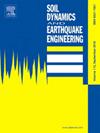Seismic performance of continuous bridges under mainshock-aftershock-like sequences with rotatable bonded laminated rubber bearings accommodating support rotation
IF 4.2
2区 工程技术
Q1 ENGINEERING, GEOLOGICAL
引用次数: 0
Abstract
Continuous bridges are often equipped with bonded laminated rubber bearings (B-LRBs) to accommodate the thermal movements of bridge superstructure. In addition to the shear and compression stresses typically experienced by B-LRBs, support rotations can introduce pure bending stresses, which pose a significant threat to the behavior of bearings. This study proposes a rotatable B-LRB configuration aimed at mitigating the adverse effects of support rotations. The longitudinal seismic responses of a two-span continuous bridge, equipped with conventional and rotatable B-LRBs, were analyzed and compared under mainshock-only and mainshock-aftershock earthquake scenarios. The results highlight the substantial impact of support rotations on bearing forces, with rotation-induced bending moments accounting for 40%–80 % of the total bending moment in conventional B-LRBs. This effect significantly increases the risk of bearing failure, which, however, can be effectively eliminated with the rotatable B-LRBs. The effectiveness of the rotatable bearings is particularly evident during mainshock-aftershock sequences. Premature failure of conventional B-LRBs during mainshocks exacerbates bridge damage in the subsequent aftershocks, leading to catastrophic consequences such as span unseating, which contradicts the seismic design strategy of ductile bridge piers. In contrast, the rotatable B-LRBs can prevent the failures associated with the bearings, contributing to a more predictable bridge seismic response.
求助全文
约1分钟内获得全文
求助全文
来源期刊

Soil Dynamics and Earthquake Engineering
工程技术-地球科学综合
CiteScore
7.50
自引率
15.00%
发文量
446
审稿时长
8 months
期刊介绍:
The journal aims to encourage and enhance the role of mechanics and other disciplines as they relate to earthquake engineering by providing opportunities for the publication of the work of applied mathematicians, engineers and other applied scientists involved in solving problems closely related to the field of earthquake engineering and geotechnical earthquake engineering.
Emphasis is placed on new concepts and techniques, but case histories will also be published if they enhance the presentation and understanding of new technical concepts.
 求助内容:
求助内容: 应助结果提醒方式:
应助结果提醒方式:


